Trees Birds Mammals Fish Amphibians Reptiles
Wild Algarve
Bookshop
Lactarius deliciosus (L.) Gray - Saffron Milkcap
Phylum: Basidiomycota - Class: Agaricomycetes - Order: Russulales - Family: Russulaceae
Distribution - Taxonomic History - Etymology - Identification - Culinary Notes - Reference Sources
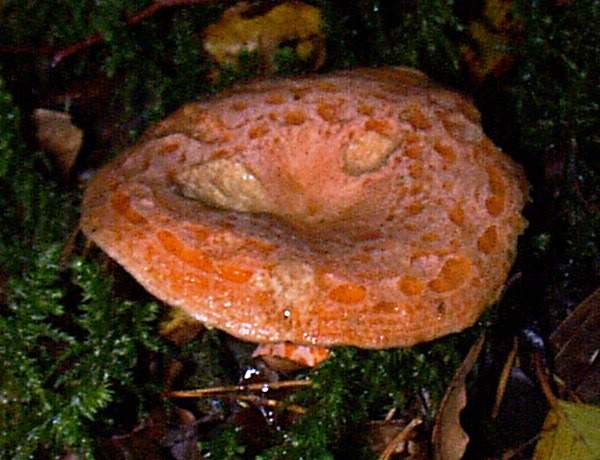
Lactarius deliciosus, known variously as either
the Delicious Milkcap or more commonly nowadays the Saffron Milkcap, is an autumn species best sought in pine forests, where it sometimes occurs in large groups, although it also appears in oak woodlands occasionally.
Distribution
Widespread but uncommon in Britain and Ireland, this kind of milkcap is found throughout Europe and in parts of North America and Australia.
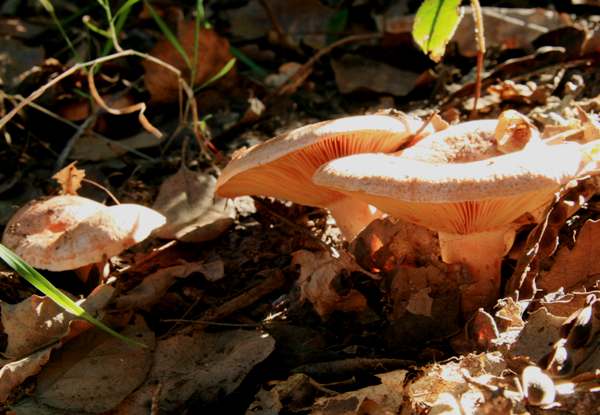
Many authorities are convinced that Lactarius deliciosus is not one but a complex (meaning a closely-related group) of species not all of which occur on both sides of the Atlantic Ocean. The Saffron Milkcap that is found in Australia is thought to be a species introduced from Europe.
Taxonomic history
This mushroom was described in 1753 by Carl Linnaeus, who gave it the binomial scientific name Agaricus deliciosus. (In the early days of fungal taxonomy most gilled fungi were initially placed in a giant Agaricus genus, now largely redistributed across many other genera.) The currently-accepted scientific name Lactarius deliciosus dates from an 1821 publication by British mycologist Samuel Frederick Gray (1766-1828).
Synonyms of Lactarius deliciosus include Agaricus deliciosus L., and Agaricus lactifluus var. deliciosus (L.) Pers.
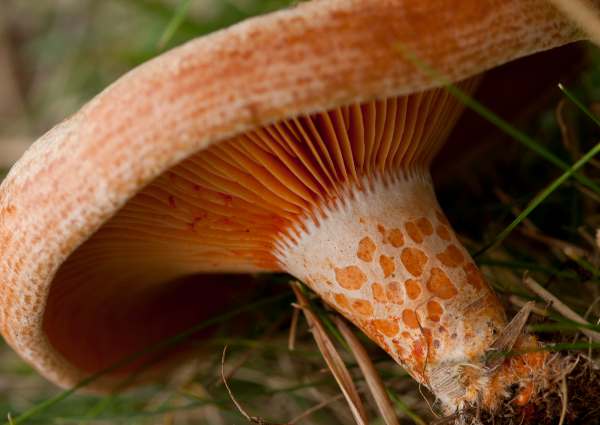
Etymology
The generic name Lactarius means producing milk (lactating) - a reference to the milky latex that is exuded from the gills of milkcap fungi when they are cut or torn - although some species provide a lot more milk than others do, and the Saffron Milkcap Lactarius deliciosus is very variable in this respect.
The specific epithet deliciosus is clear evidence that Carl Linnaeus had more than a scientific interest in fungi and that he considered the Saffron Milkcap to be delicious to eat. (Many great mycologists, past and present, enjoy eating wild mushrooms.)
In the USA this species (or more strictly a species currently sharing the same scientific name but questionably co-specific) is commonly referred to as either the Saffron Milk Cap or the Red Pine Mushroom.
Identification guide
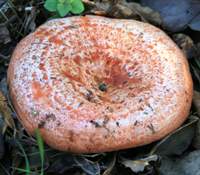
|
Cap
The caps are 6 to 20cm in diameter; convex and then
depressed; reddish orange, bruising green; surface granular becoming
sticky when wet.
Young caps have inrolled margins and are pinkish-orange. Older
specimens are vase-shaped with sharpish rims, and they often develop faint pistachio-green irregular patches. |
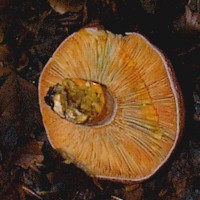
|
Gills
The gills of this milkcap are shortly
decurrent, crowded and bright orange,
staining green when bruised.
When cut, the gills release bright red-orange (carrot coloured) latex that
eventually turns wine red. |
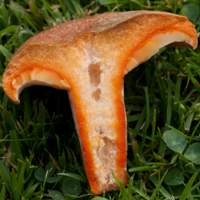 |
Stem
Hollow and relatively short, 5 to 8cm long and 1.5 to 2cm diameter, the
stem has a surface marked
with a random sprinkling of shallow bright-orange pits (known as scrobiculations), especially near the base. |
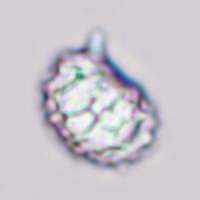 |
Spores
Ellipsoidal, 7-9 x 6-7µm; ornamented with a well-defined and almost complete network of ridges.
Spore print
Pale pinkish buff. |
Odour/taste |
Fruity smell; the milk (latex) has a mild
taste, becoming slightly bitter after a while. |
Habitat & Ecological role |
Mycorrhizal, in coniferous woodland, particularly under pines. |
Season |
August to October in Britain and Ireland. |
Similar species |
Lactarius torminosus is more pink, has a woolly cap margin
and is always close to birch trees.
Lactarius deterrimus has a smooth stem; its mild milk is
pinkish-orange. |
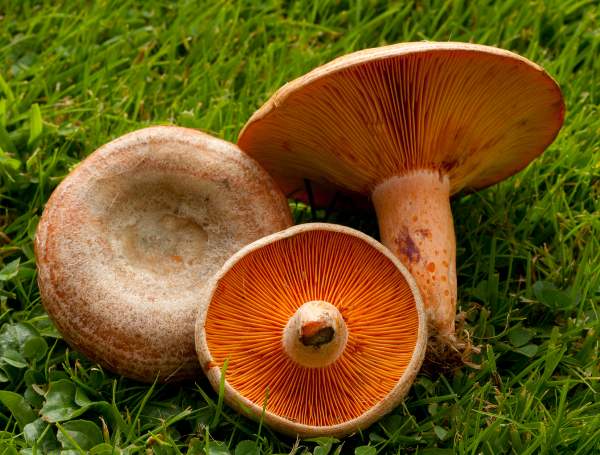
Culinary Notes
As its specific epithet proclaims, this large milkcap is generally considered to be a good edible mushroom (although many fungiphages say that there are in fact several superior milkcaps, supreme among which is probably Lactarius sanguifluus). It may be that the differing views about edibility of the Saffron Milkcap arises because the various species or sub-species within the Lactarius deliciosus complex differ significantly in their texture and flavour.
This milkcap is good if cut into thin strips and grilled with steak and onions. Some people prefer them cooked slowly to remove any bitterness and the slightly fibrious texture that they can have if they are simply flash fried. Young caps, with their exaggeratedly inrolled margins, are generally
considered the best ones for eating.
Reference Sources
Fascinated by Fungi, 2nd Edition, Pat O'Reilly 2016, reprinted by Coch-y-bonddu Books in 2022.
Funga Nordica, Henning Knudsen and Jan Vesterholt, 2008.
Fungi of Switzerland, volume 6: Russulaceae, Kränzlin, F.
BMS List of English Names for Fungi.
Dictionary of the Fungi; Paul M. Kirk, Paul F. Cannon, David W. Minter and J. A. Stalpers; CABI, 2008
Taxonomic history and synonym information on these pages is drawn from many sources but in particular from the British Mycological Society's GB Checklist of Fungi.
Acknowledgements
This page includes pictures kindly contributed by David Kelly.
Top of page...
Fascinated by Fungi. Back by popular demand, Pat O'Reilly's best-selling 450-page hardback book is available now. The latest second edition was republished with a sparkling new cover design in September 2022 by Coch-y-Bonddu Books. Full details and copies are available from the publisher's online bookshop...